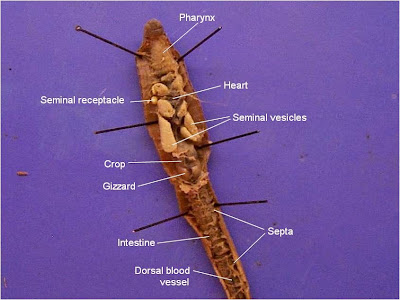- What surprised me from the worm dissection was that a once living organism can function with such small organs, digestive systems, etc.
- It also surprised me that there were little to no fluids inside of the worm while I was dissecting it.
- Also the organ system is very simple, and not as complex as a human being organism.
My Blog List
4.28.2011
Blog #12 (Worm Dissection)
Blog#12 What surprised you from the worm's dissection?
4.18.2011
Blog #11 (Generations)
Blog #11
Get a picture of alternation of generations put it in your blog and explain how it relates to plants
Starting with the diploid plant, its cells under go Meiosis, this reduces the Diploid cells to Haploid cells. These Haploid cells do not fertilize other Haploid gametes and therefore undergo further Mitosis to yield a Haploid plant. As Mitosis continues these Haploid cells can fertilize/ be fertilized by Haploid gametes. This yields a Diploid cell which under further Mitosis yields the Diploid plant we started with (2 generations prior).
Get a picture of alternation of generations put it in your blog and explain how it relates to plants
Starting with the diploid plant, its cells under go Meiosis, this reduces the Diploid cells to Haploid cells. These Haploid cells do not fertilize other Haploid gametes and therefore undergo further Mitosis to yield a Haploid plant. As Mitosis continues these Haploid cells can fertilize/ be fertilized by Haploid gametes. This yields a Diploid cell which under further Mitosis yields the Diploid plant we started with (2 generations prior).
4.14.2011
Blog #10 (Dissecting)
Why is dissection an important part of a biology curriculum? Which animals and/or plants should be included in biological studies?
Dissection is defined as the process of disassembling and observing something to determine its internal structure and as an aid to discerning the functions and relationships of its components. I believe that dissections are vital to Biology because, we are allowed to see the inside of the organs, etc that we couldn't see with the normal MRI. By dissecting a dead animal you are able to examine the organs and see how the animal died, which can help use see if it had any disorders that led to the death
I believe that ANY animal should be included in Biological studies, even endangered species. I am not suggesting killing the animal, but after the animal is dead you should be allowed to be allowed to dissect the animal for studies. I believe this because Biology isn't limited to any one species, also because of the fact that animal facts are based on animal testing. All shampoos, cosmetics, and pharmaceutical drugs are all made possible and are ensured as safe for human use, by the testing of the animals.
Dissection is defined as the process of disassembling and observing something to determine its internal structure and as an aid to discerning the functions and relationships of its components. I believe that dissections are vital to Biology because, we are allowed to see the inside of the organs, etc that we couldn't see with the normal MRI. By dissecting a dead animal you are able to examine the organs and see how the animal died, which can help use see if it had any disorders that led to the death
I believe that ANY animal should be included in Biological studies, even endangered species. I am not suggesting killing the animal, but after the animal is dead you should be allowed to be allowed to dissect the animal for studies. I believe this because Biology isn't limited to any one species, also because of the fact that animal facts are based on animal testing. All shampoos, cosmetics, and pharmaceutical drugs are all made possible and are ensured as safe for human use, by the testing of the animals.
Blog #9 (Community Interaction)
Define the different forms of community interaction: competition, commensalism, mutualism, predation, parasitism Give an example and a picture for each
Competition: contest between individuals, groups, animals, etc. for territory, a niche, or a location of resources. Competition occurs naturally between living organisms which co-exist in the same environment.
predation:describes a biological interaction where a predator (an organism that is hunting) feeds on its prey (the organism that is attacked)
parasitism: is a type of symbiotic relationship between organisms of different species where one organism, the parasite, benefits at the expense of the other, the host.
Competition: contest between individuals, groups, animals, etc. for territory, a niche, or a location of resources. Competition occurs naturally between living organisms which co-exist in the same environment.
Commensalism: a class of relationship between two organisms where one organism benefits but the other is neutral (there is no harm or benefit).
mutualism:is the way two organisms biologically interact where each individual derives a fitness benefit predation:describes a biological interaction where a predator (an organism that is hunting) feeds on its prey (the organism that is attacked)
parasitism: is a type of symbiotic relationship between organisms of different species where one organism, the parasite, benefits at the expense of the other, the host.
Subscribe to:
Posts (Atom)






